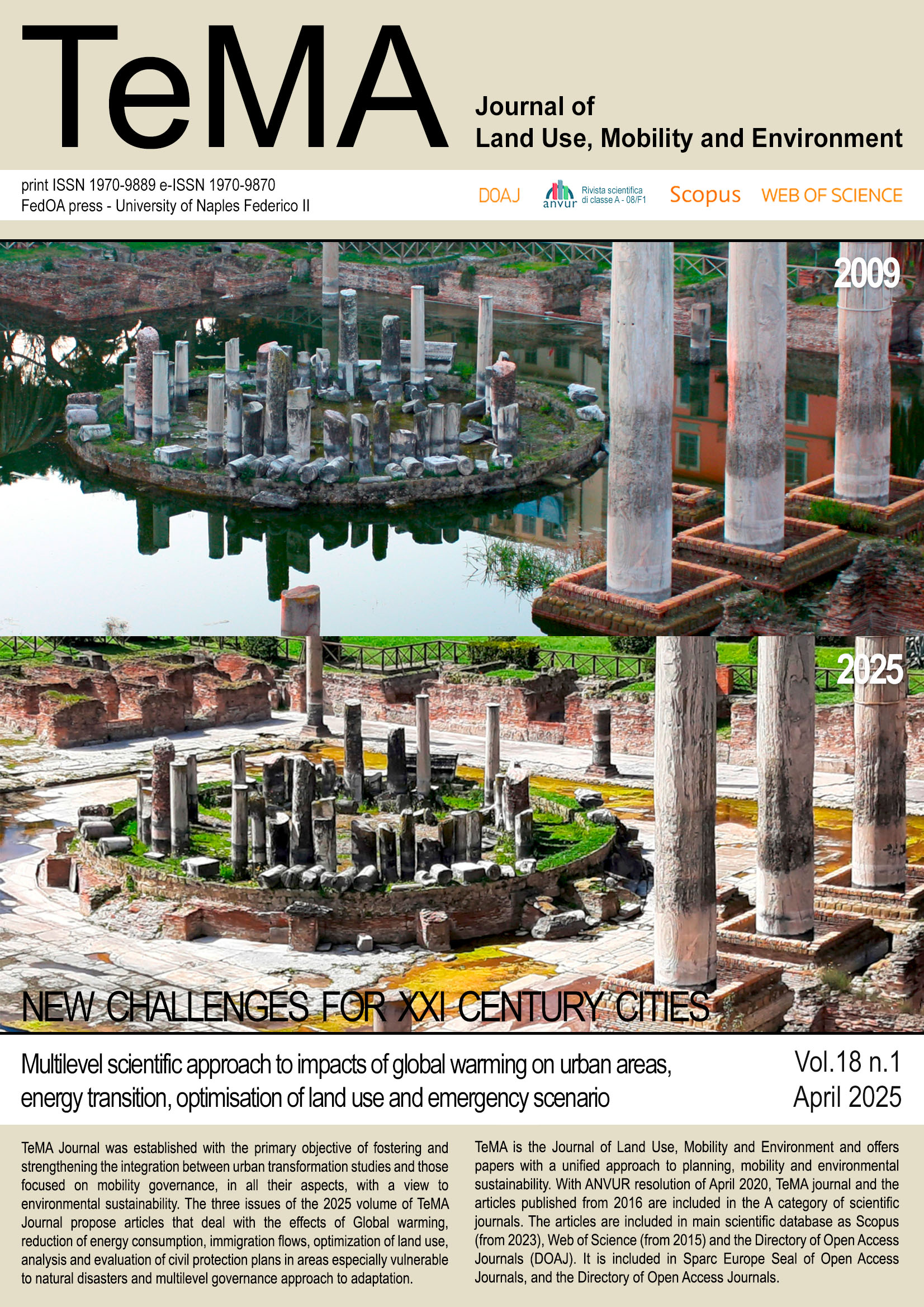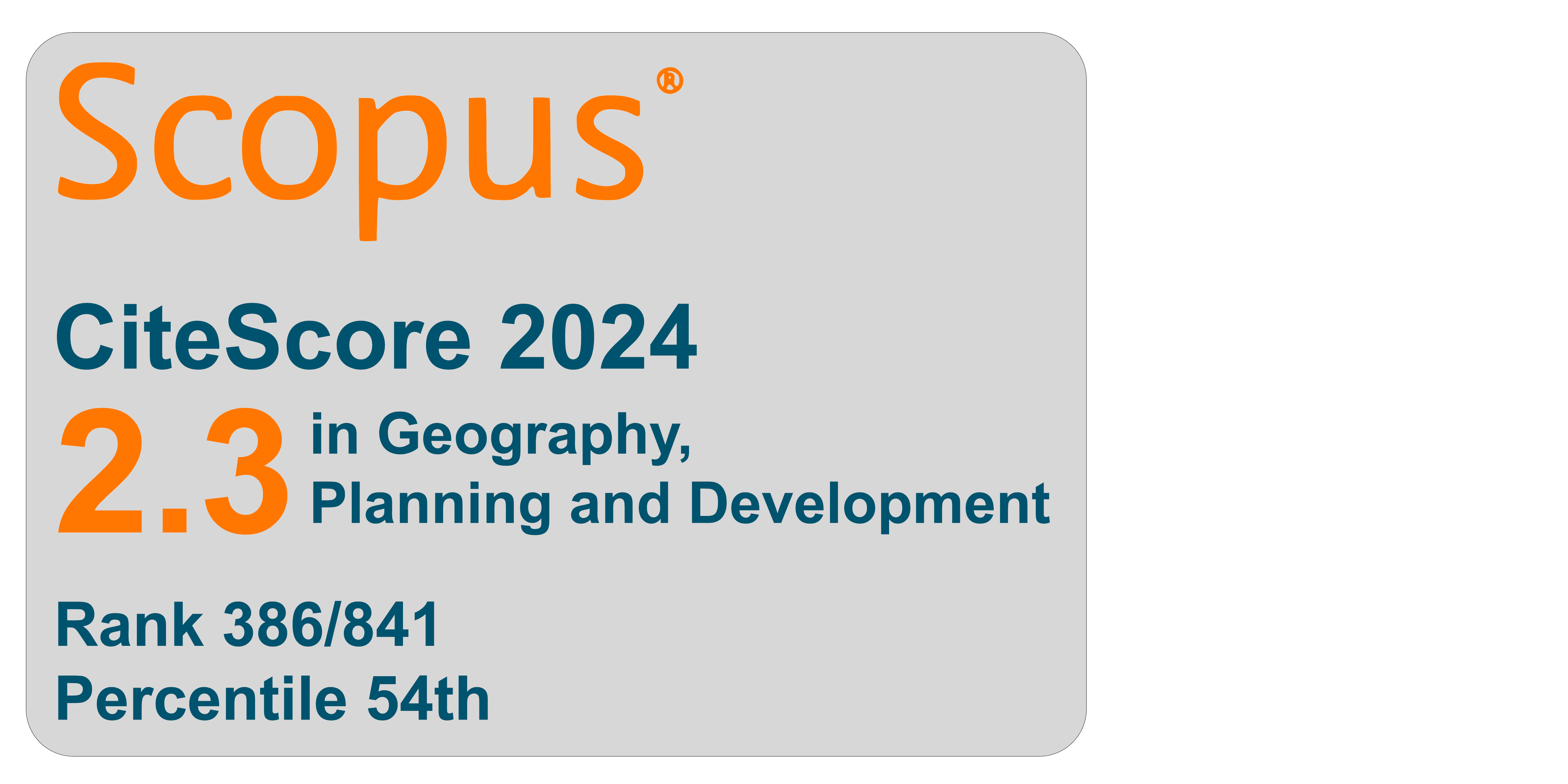The impact of transportation planning on agricultural areas and plant health: a case study of Antalya/Konyaaltı West Ring Road
DOI:
https://doi.org/10.6093/1970-9870/11174Keywords:
Agricultural land, Change detection, GIS, NDVI, Ring Road, Transportation-land useAbstract
It is stated in the literature that changes in land cover/land use may have positive or negative effects on accessibility and rural-urban distinction in the region. Similarly, increasing accessibility in an area may lead to unplanned urbanization, traffic congestion, air and noise pollution, and a decrease in environmental quality of life due to the impact on land use, and most importantly, destruction of agricultural areas. In the planning of urban and rural areas, the interaction with each other and the formal separation of rural and urban areas are important, and many analyses such as accessibility, protection of agricultural areas, building density and population should be carefully made in order to avoid negative impacts on each other. In the studies carried out without such analyses, unplanned or unjustified urban areas emerge where the direction of urban development has not been determined. In this study, the West Ring Road in the Konyaaltı district (Antalya), where a similar situation is experienced, and the surrounding agricultural areas are analyzed. It is claimed that the agricultural lands around the West Ring Road have lost their agricultural quality. With this study, we seek empirical answers to these claims. Our aim is to analyze the effects of the West Ring Road on the agricultural areas around it, in conjunction with plant health, through GIS (Geographic Information System) and Remote Sensing methods. As a result of the study, the plant health in the rural agricultural areas on the periphery of the West Ring Road was not negatively affected.
Downloads
References
Afira, N. & Wijayanto, A. W. (2022). Mono-temporal and multi-temporal approaches for burnt area detection using Sentinel-2 satellite imagery (a case study of Rokan Hilir Regency, Indonesia). Ecological Informatics, 69, 101677. https://doi.org/10.1016/j.ecoinf.2022.101677
Alonso, W. (1964). Location and land use: Toward a general theory of land rent. Harvard University Press. https://doi.org/10.4159/harvard.9780674730854
Alphan, H. (2003). Land‐use change and urbanization of Adana, Turkey. Land Degradation & Development, 14 (6), 575-586. https://doi.org/10.1002/ldr.581
Anas, A. (1982). Residential location markets and urban transportation: Economic theory, econometrics, and policy analysis with discrete choice models. Academic Press.
Arima, E. Y., Walker, R. T., Perz, S. G. & Caldas, M. (2005). Loggers and forest fragmentation: Behavioral models of road building in the Amazon basin. Annals of the Association of American Geographers, 95 (3), 525-541.
Boyce, D. E. (1980). A framework for constructing network equilibrium models of urban location. Transportation Science, 14 (1), 77-96. https://doi.org/10.1287/trsc.14.1.77
Brandi, A., Gori, S., Nigro, M., & Petrelli, M. (2014). Development of an integrated transport-land use model for the relocation of activities in urban areas. Transportation Research Procedia, 3, 374-383. https://doi.org/10.1016/j.trpro.2014.10.119
Brereton, F., Bullock, C., Clinch, J. P., & Scott, M. (2011). Rural change and individual well-being: The case of Ireland and rural quality of life. European Urban and Regional Studies, 18 (2), 203-227. https://doi.org/10.1177/0969776411399346
Buliung, R. N. & Kanaroglou, P. S. (2006). A GIS toolkit for exploring geographies of household activity/travel behavior. Journal of Transport Geography, 14 (1), 35-51. https://doi.org/10.1016/j.jtrangeo.2005.05.002
Caprari, G. & Malavolta, S. (2024). Analysis of territorial fragilities through GIScience. TeMA - Journal of Land Use, Mobility and Environment, 169-190. https://doi.org/10.6092/1970-9870/10200
Chávez Michaelsen, A., Huamani Briceño, L., Fernandez Menis, R., Bejar Chura, N., Valera Tito, F., Perz, S., Brown, I. F., Domínguez Del Aguila, S., Pinedo Mora, R. & Alarcón Aguirre, G. (2013). Regional deforestation trends within local realities: land-cover change in southeastern Peru 1996–2011. Land, 2 (2), 131-157. https://doi.org/10.3390/land2020131
Dahanayake, H. D., Dahanayaka, D. D. G. L., Hudson, P. & Wickramasinghe, D. (2024). Land use changes of coastal wetlands using remote sensing. A case study of Muthurajawela & Anawilundawa wetlands, Sri Lanka. TeMA - Journal of Land Use, Mobility and Environment, 17 (1), 7-21. https://doi.org/10.6093/1970-9870/10281
Demirel, H. (2004). A dynamic multi-dimensional conceptual data model for transportation applications. ISPRS Journal of Photogrammetry and Remote Sensing, 58 (5-6), 301-314.
Esopi, G. (2018). Urban commons: social resilience experiences to increase the quality of urban system. TeMA - Journal of Land Use, Mobility and Environment, 11 (2), 173-194. https://doi.org/10.6092/1970-9870/5532
Foth, N., Manaugh, K. & El-Geneidy, A. M. (2013). Towards equitable transit: examining transit accessibility and social need in Toronto, Canada, 1996-2006. Journal of Transport Geography, 29, 1-10. https://doi.org/10.1016/j.jtrangeo.2012.12.008
Futemma, C. & Brondízio, E. S. (2003). Land reform and land-use changes in the lower Amazon: Implications for agricultural intensification. Human Ecology, 31, 369-402. https://doi.org/10.1023/A:1025067721480
Geurs, K. T. & van Wee, B. (2004). Land-use/transport interaction models as tools for sustainability impact assessment of transport investments: review and research perspectives. European Journal of Transport and Infrastructure Research, 4 (3), 127-140. https://doi.org/10.1016/j.jtrangeo.2003.10.005
Hatfield, J., Kanemasu, E., Asrar, G., Jackson, R., Pinter Jr, P., Reginato, R. & Idso, S. (1985). Leaf-area estimates from spectral measurements over various planting dates of wheat. International Journal of Remote Sensing, 6 (1), 167-175.
Hawkins, J. & Nurul Habib, K. (2019). Integrated models of land use and transportation for the autonomous vehicle revolution. Transport Reviews, 39 (1), 66-83. https://doi.org/10.1080/01441647.2018.1507893
Huang, H., Roy, D. P., Boschetti, L., Zhang, H. K., Yan, L., Kumar, S. S., Gomez-Dans, J. & Li, J. (2016). Separability analysis of Sentinel-2A Multi-Spectral Instrument (MSI) data for burned area discrimination. Remote Sensing, 8 (10), 873. https://doi.org/10.3390/rs8100873
Ing, C., Beattie, C. & Longhurst, J. (2001). Progress with implementing local air-quality management in rural areas of England. Journal of Environmental Management, 61(2), 137-147. https://doi.org/10.1006/jema.2000.0403
Khatua, A., Goswami, A. K. & Aithal, B. H. (2024). Building type classification using deep learning for transport planning. TeMA - Journal of Land Use, Mobility and Environment, 18 (3), 397-410. https://doi.org/10.6092/1970-9870/10201
Kaliraj, S., Chandrasekar, N., Ramachandran, K., Srinivas, Y. & Saravanan, S. (2017). Coastal landuse and land cover change and transformations of Kanyakumari coast, India using remote sensing and GIS. The Egyptian Journal of Remote Sensing and Space Science, 20(2), 169-185. https://doi.org/10.1016/j.ejrs.2017.04.003
Kandemir, E. (2010). Uzaktan algılama tekniğinde NDVI değerleri ile doğal bitki örtüsü tür dağılımı arasındaki ilişkilerin belirlenmesi üzerine araştırmalar. Fen Bilimleri Enstitüsü, Çevre Bilimleri Ana Bilim Dalı, Yüksek Lisans Tezi, 60.
Lefebvre, H. (2003). The urban revolution. University of Minnesota Press.
Lopez-Ruiz, H. G., Christidis, P., Demirel, H. & Kompil, M. (2013). Quantifying the effects of sustainable urban mobility plans. Report EUR, 26123.
Partheepan, K., Musthafa, M. M. & Bhavan, T. (2023). Remote sensing investigation of spatiotemporal land-use changes. TeMA - Journal of Land Use, Mobility and Environment, 16 (2), 383-402. https://doi.org/10.6093/1970-9870/9908
Poudel, S., Shahnawaz, S. & Shrestha, H. L. (2023). Suitable sites for built-up area expansion in Kamalamai municipality, Sindhuli district, Nepal. TeMA - Journal of Land Use, Mobility and Environment, 16 (2), 279-305. https://doi.org/10.6093/1970-9870/9968
Samal, D. R. & Gedam, S. S. (2015). Monitoring land use changes associated with urbanization: An object-based image analysis approach. European Journal of Remote Sensing, 48 (1), 85-99. https://doi.org/10.5721/EuJRS20154806
Samat, N., Ghazali, S., Hasni, R. & Elhadary, Y. A. E. (2020). Land Use Change, Spatial Interaction, and Sustainable Development in the Periphery of the Metropolitan Region. Land, 9 (3), 95. https://doi.org/10.3390/land9030095
Sietchiping, R., Kago, J., Zhang, X. Q., Augustinus, C. & Tuts, R. (2014). Role of urban–rural linkages in promoting sustainable urbanization. Environment and Urbanization Asia, 5 (2), 219-234. https://doi.org/10.1177/0975425315577170
Singh, A. (1989). Review article digital change detection techniques using remotely-sensed data. International Journal of Remote Sensing, 10 (6), 989-1003. https://doi.org/10.1080/01431168908903939
Suri, L. (2018). Planlamada Doğal Eşik Değerlendirme Kriterleri. İstanbul Ticaret Üniversitesi Fen Bilimleri Dergisi, 17 (34), 47-67.
Tao, L. (2007). A Study of the Tibetan Rural Urbanisation Model. China Report, 43 (1), 31-42. https://doi.org/10.1177/000944550704300103
Teodoro, A. & Amaral, A. (2019). A statistical and spatial analysis of Portuguese forest fires in summer 2016 considering Landsat 8 and Sentinel 2A data. Environments, 6 (3), 36. https://doi.org/10.3390/environments6030036
Tondelli, S., Bartolacci, S. & De Medici, S. (2017). Urban growth and planning sustainability: The role of natural and artificial thresholds. TeMA - Journal of Land Use, Mobility and Environment, 10 (2), 153-172. https://doi.org/10.6092/1970-9870/5532
Tucker, C. J. (1979). Red and photographic infrared linear combinations for monitoring vegetation. Remote Sensing of Environment, 8 (2), 127-150. https://doi.org/10.1016/0034-4257(79)90013-0
Wang, J., Wei, H., Cheng, K., Li, G., Ochir, A., Bian, L., Davaasuren, D., Chonokhuu, S. & Nasanbat, E. (2019). Spatio-temporal pattern of land degradation along the China-Mongolia railway (Mongolia). Sustainability, 11 (9), 2705. https://doi.org/10.3390/su11092705
Wegener, M. & Fürst, F. (2004). Land-use transport interaction: State of the art. Available at SSRN 1434678. https://doi.org/10.2139/ssrn.1434678
Zhu, X. & Liu, S. (2004). Analysis of the impact of the MRT system on accessibility in Singapore using an integrated GIS tool. Journal of Transport Geography, 12 (2), 89-101. https://doi.org/10.1016/j.jtrangeo.2003.10.005
Downloads
Published
How to Cite
License
Copyright (c) 2025 TeMA - Journal of Land Use, Mobility and Environment

This work is licensed under a Creative Commons Attribution-NonCommercial 4.0 International License.



